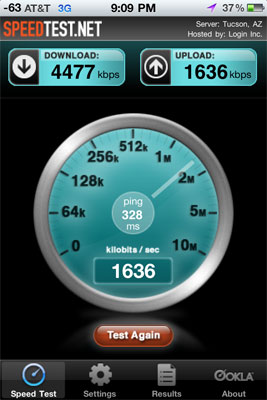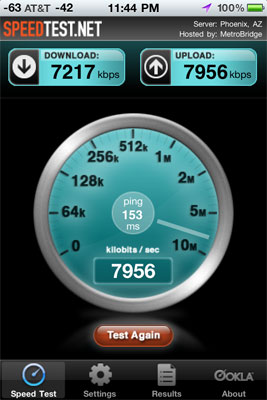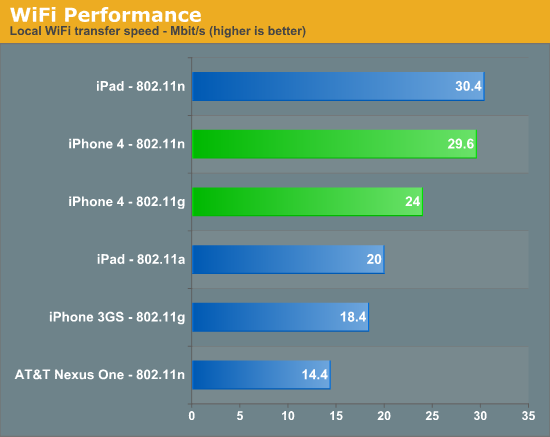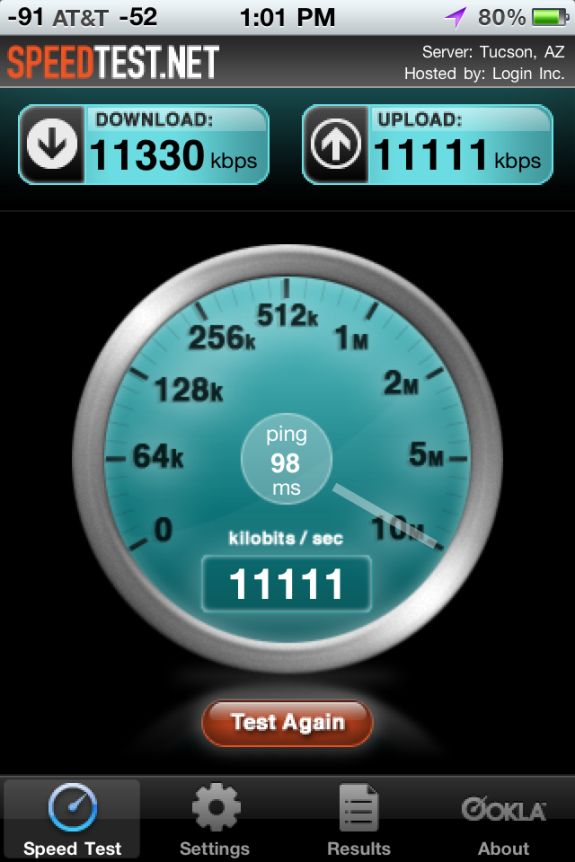Apple's iPhone 4: Thoroughly Reviewed
by Brian Klug & Anand Lal Shimpi on June 30, 2010 4:06 AM EST- Posted in
- Smartphones
- Apple
- iPhone 4
- Gadgets
- Mobile
Network Improvements
The iPhone continues to be an AT&T exclusive in the US. With the iOS 4 upgrades the iPhone 4 supports tethering over Bluetooth or USB. The feature is an extra $20 per month on top of your existing iPhone data plan and it also deducts bandwidth from the 2GB you get with the data plan. It's not a coincidence that AT&T timed the release of its iPhone tethering option with the move away from unlimited data plans. You don't have to give up your existing unlimited data plan if you don't want to, however if you want to enable tethering you have to sign up for the new $25/2GB plan.
I'm not a huge fan of iPhone tethering right now because despite paying for the service and having full signal strength on AT&T, I'm getting horrible transfer rates while trying to upload this article. I had to sign up for airport WiFi to get it live, thanks AT&T. When it does work however, it works well. As you'll see later you can easily get multiple Mbps out of AT&T's network in areas with good coverage. That easily equals the lower end of what you'd see from WiMAX today. As I've mentioned before however, it's really hit or miss with AT&T. The network is either great or totally unusable, while its competitors are generally more consistent but never quite as fast. I'd say that there's a good chance Apple will bring the iPhone to Verizon, it's just a matter of when.
| Cost of Ownership Comparison | |||||
| AT&T iPhone 4 | Sprint EVO 4G | Verizon HTC Droid Incredible | |||
| Cost of Device | $199 w/ 2 year contract | $199 w/ 2 year contract after $100 MIR | $199 w/ 2 year contract | ||
| Plan with 900 Minutes, Unlimited SMS/Data | $104.99/mo, unlimited SMS, 2GB data | $99.99/mo, unlimited SMS, unlimited data, 4G | $109.98/mo, unlimited SMS, unlimited data | ||
| Tethering | + $20/mo | + $29.99/mo | + $25/mo* | ||
| Total Monthly + Tethering | $124.99/mo | $129.98/mo | $134.98/mo | ||
| Total Cost of Ownership over 2 Years | $2718.76 | $2598.76 after $100 MIR | $2838.52 | ||
| Total Cost of Ownership over 2 Years w/ Tethering | $3198.76 | $3318.52 after $100 MIR | $3438.52 | ||
AT&T's plans are actually reasonably priced if you don't go over the data limits. A $15/mo data plan will get you 200MB of transfers per month and $25 will give you 2GB. For users like my parents the 200MB option is great. Even for me personally, 2GB is fine. I tend to peak at 700MB per month, but that's because at the office I'm almost always on my desktop or connected via WiFi. It's unclear how tethering is going to change this for me. Our own Brian Klug on the other hand easily pushes more than 2GB of transfers per month. So AT&T's rate switch is either going to save you a few bucks per month or make you really unhappy.
The iPhone 4 brings HSUPA class 6 for upload speeds of up to 5.76 megabits/s to the platform. This is a 15 fold improvement over the 384 kilobits/s maximum of the iPhone 3G and 3GS, which I routinely see. Not all AT&T markets are updated to HSUPA, and in practice I saw uploads of around 1.5 megabits/s, in line with class 2 or class 3 HSUPA.
Downstream HSDPA speeds remain unchanged from the 3GS, supporting up to 7.2 megabit/s HSDPA. I'm lucky since my market is HSDPA 7.2, as I routinely see speedtests of 5 megabits/s or above very late at night when there isn't very much plant load. I haven't seen any measurable increase in speeds over the 3GS, except in locations with very low signal as noted before.

My fastest iPhone 4 speedtest so far
Even Anand in one of the slowest 3G cities in the US saw significant improvements with the iPhone 4. AT&T's network in general seems to be improving. While the best he'd been able to achieve was around 1Mbps a year ago, these days he can break 2.5Mbps down during the evenings.

iPhone 4 speedtest in Raleigh, NC
WiFi speeds have also improved, as Apple has added 802.11n in the 2.4 GHz band. 5 GHz support remains absent, something which would have likely complicated antenna design even further. Interestingly enough, the BCM4329 WiFi and Bluetooth SoC does contain 802.11a 5 GHz support, the reason it's disabled is again likely due to antenna design constraints. The Broadcom SoC also includes an FM tuner and transmitter, though support for either remains and sadly (given Apple's historical lack of FM radio support) will remain such. Bluetooth 2.1 EDR is there as well.
The iPhone 4 seems to connect at 802.11n rates of 72 megabits/s in best case, far from the maximum without channel bonding of 150 megabits/s. This is still a welcome improvement from the 802.11b/g in the iPhone 3GS, which seemed to never connect above b rates in practice. As an aside, mobile devices using 802.11b rates (modulated using DSSS) are a huge contributing factor to WiFi congestion at conferences - I've even seen DSSS modulated rates (and thus 802.11b devices) explicitly disallowed from connecting to APs at conferences. It's a welcome improvement to see iPhone bringing N support.

A typical WiFi test result
However, even on my 25/4 DOCSIS 3 cable connection, I could only squeeze out a maximum of 8.5 megabits/s down and 8.0 megabits/s up while connected at 72 megabits/s best case. This was using the speedtest.net app to a local test location. I tried with an Airport Extreme (new generation), a WRT600N running DD-WRT, and a WRT54GL-TM running Tomato. All three showed similar results capping out around 8 megabits/s down when I could run tests in excess of 30 megabits down on my desktop. This is probably more of a CPU bottleneck appearing than anything else.
Update:
I thought there was something wrong with my WiFi performance, turns out the iPhone 4 is indeed faster than a palty 8 megabits/s. ;)
There were a number of comments by folks who were able to run speedtest.net and get throughput above 10 or 11 megabits/s. Testing earlier today on a much faster connection, I managed to get something in line with their numbers:
Early today, the folks at DigitalSociety also managed to get much faster WiFi speeds in the neighborhood of 20 megabits/s, way higher than my meager 8 megabits/s. To do so, they loaded an MP3 in safari stored on a local webserver and watched network utilization. I wish I had thought of this, because it's perfect. In the past, the speedtest.net app always used to saturate my connection over WiFi. My only explanation is that the application performs slower over WiFi in iOS 4 than it did in iOS 3, something Anand noted as well. Thanks for all the heads up messages, everyone!
I set up a similar test to DigitalSociety's. I opened an 85 MB PDF stored on my local web server in the browser of each device and watched network utilization using bwm-ng. I tested with an Airport Extreme connected over gigabit to my webserver with no other network utilization. I took the average of 5 runs on the iPad, iPhone 4, iPhone 3GS, and my AT&T Nexus One running Froyo 2.2 (which is 802.11n). The results are much, much more in line with earlier expectations.

The iPhone 4 comes close to but can't quite best the iPad, though the difference is minimal. I did notice that the iPad associates at the same 72 megabits/s connection speed as the iPhone 4. Thankfully, the iPhone 4 easily bests the iPhone 3GS. Finally, although the AT&T Nexus One associates at an 802.11n rate of 65 megabits/s, it's slower than the iPhone 3GS. I have a feeling the device is writing the PDF into flash, whereas the iOS devices are loading it into memory.











270 Comments
View All Comments
Belard - Friday, July 2, 2010 - link
On the back of all iPhones... whats with the ugly logos on the back of the phones?I don't know another phone that has such things and you'd think on a style-brand such as Apple, they really would work to NOT put such things on.
Look at the HTC-EVO review. Other than HTC & Sprint logos, its all nice and clean looking.
My SONY phones... only say Sony. Even the bottom of my Logitech mouse only has a CE logo and product text "DUAL LASER".
mikelward - Friday, July 2, 2010 - link
The Nexus One photos looked much better to me. The iPhone 4 was too yellow and the Evo was too noisy.Out of interest, is this something that could be fixed in a firmware update, and what version of Android was the N1 running?
Thank you very much for the review, especially the antenna section.
QuantumForce - Friday, July 2, 2010 - link
Did you average dBs as if they were linear numbers? Really? They are a log transform of a ratio between measured and standard linear intensity or pressure. 20 dB * 2 is not equal to 40 dB. Just how did you deal with the math here in your sample analysis of six readings?
metalev - Friday, July 2, 2010 - link
I re-charted the signal strength quoted in this article to make the huge signal strength range given to 5 bars much more obvious:http://www.metalev.org/2010/07/apple-caught-red-ha...
KOTULCN - Saturday, July 3, 2010 - link
You said you restored your iPhone 4 to a back-up of a jail broken 3.1.3? Alittle bit more explanation is due!MrBrownSound - Saturday, July 3, 2010 - link
Very detailed review. In the end with Froyo coming I'd have to choose Evo no matter the extended wait because of integration with sense UI. Although I will have to compromise battery life, stunning display and sheer expensive look and feel compared to the iphone. To make up for it I will be able to make calls, have a bigger screen, and also have the all open android OS. trade-offs trade-offs. I'll take it over being locked to at&t for two years with three hundred something termination fee.Again very thorough review. This is why i read Anandtech
spiritu - Saturday, July 3, 2010 - link
I note that some subtle but significant changes have been made to your article since it was first published.In particular, the following line:
It originally said:
"Apple should add an insulative coating to the stainless steel band (which implies a recall), or subsidize bumper cases." (which implies apple should pay for the cost of the bumper)
Now it says:
"The most sensitive region of the antenna should have an insulative coating (next time round?), or everyone should use a case. (which implies the user should buy a bumper).
I can only presume that you made these changes under duress.
orangpelupa - Saturday, July 3, 2010 - link
great review. very in-depth. Nice knowing what the reason behind iPhone 4 "signal problem".btw
seeing this
http://images.anandtech.com/doci/3794/iPhone4-3422...
i got struck by nostalgic feeling :D
it really looks like my 4 years old cellphone. (now its dead lol)
Sony Ericsson M600i.
http://img23.imageshack.us/img23/9964/030720101018...
the "sides" design really remind me of my old phone :)
drwho9437 - Saturday, July 3, 2010 - link
"The Antenna is Improved" is a subheading. The content is more or less fine, but it shouldn't be called the Antenna is improved. If the software is correctly reporting the number of dBm and it just works at lower levels because of a lower noise floor in the RF amplifier, then you should say "reception is Improved" or something.The improvement in the signal is down to the mixer, amp or filters not the antenna gain as you note from your dBm level measures.
Axelband - Saturday, July 3, 2010 - link
This is simply the best and most thorough product review I have ever read. It had just enough technical information to satisfy an engineer like me but not too much to bore a layman. Bookmarking your site now.